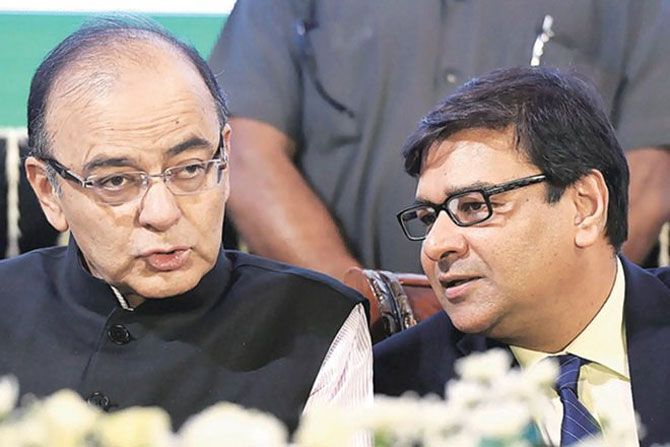'The one sector where there is still a sense of crisis is banking, but the government has regrettably set its face against privatising any of the government-owned banks,' says T N Ninan.

IMAGE: Finance Minister Arun Jaitley and Reserve Bank of India Governor Dr Urjit Patel. Photograph: PTI
Economic growth is back above 7 per cent, and one could speculate whether a window of opportunity for reform has just closed.
Though the Narendra D Modi government started out promising double digit growth, it will be relieved that, after four rocky quarters, the magic number '7' defines growth once again.
Yet these troublesome quarters have seen more substantive ground-level reform than previous years when it was relatively smooth sailing for the government.
We have implementation of the new bankruptcy code, introduction of the goods and services tax, large-scale recapitalisation of banks, and de-nationalisation of coal mining.
But as the sense of crisis fades, and thoughts turn increasingly to the next Lok Sabha elections, it would be an understandable question whether this action-oriented reform impulse will subside, especially since the latest measures (a loosening of government purse strings, and across-the-board jacking up of import tariffs) are the opposite of reform.
The one sector where there is still a sense of crisis is banking, but the government has regrettably set its face against privatising any of the government-owned banks. Instead, it would seem to be considering a banks holding company.
If this amounts to nothing more than the formalisation of what the Banks Board Bureau is supposed to have done, it is unlikely to be a solution.
More direct reform, even if piecemeal, would be for the government to announce that the most trouble-prone bank will be offered to bidders, as an example to be made of.
If this is presented as an exception rather than a broader policy shift, it might run into less of a political headwind.
If the bank does well under new ownership, and therefore provides proof of concept, it would provide justification for the next step of privatising some more banks.
As things stand, though, attention has to be focused on forcing these banks to function within tighter operational norms, the objective being to improve their defective credit culture.
The Reserve Bank, therefore, did well last month to announce a new framework that shifts the effort away from playing around creatively with asset classification by banks, to one that determines the viability of borrowers -- to be discovered through application of the new bankruptcy code to a much broader category of loan accounts.
This could take the best part of four years. The first two years will be for progressively extending coverage under the code, moving from accounts larger than Rs 30 billion currently to the Rs 20 billion category, and then in stages to all credit accounts extending down to Rs 1 billion.
There is then the six-month time window for the bank management to fix an account that has gone bad, and failing that a further nine-month window for the auction process that will end with handing over the company to new owners, or shutting down.
What this means is that a process that began in 2015 with forcing banks to be more transparent about bad loans, and introducing in Parliament the Bill for instituting the bankruptcy code, will have extended for between six and seven years before we reach the end of the tunnel.
If the process works well, then new problems will be dealt with promptly and prevent another prolonged build-up of undisclosed problems, and (one hopes) prevent also the sight of sundry businessmen making off to distant lands with easily acquired loot.
The entire process is bound to be costly for the government, which means the taxpayer. Given the scale of haircuts that banks are likely to take on accounts that go into auction, the government may well need to pump even more capital into the banks that it owns.
The bill can be avoided if a progressive privatisation policy is put in place. Even if not, the government will need to look to the public-private mix that would work well for the economy.
A banking system that is 70 per cent government-owned is no sensible person's prescription of an ideal structure, especially in the context of an interventionist government culture.









